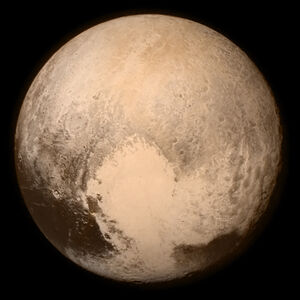
Pluto as seen by New Horizons in July 2015.
Pluto, or 134340 Pluto, is a TNO in the Kuiper belt.
Characteristics
- Tilted orbit
Similar to other dwarf planets in the Kuiper Belt, Pluto has an orbit that is so tilted, that it crosses the orbit of Neptune and the other Plutoids (all 3 Kuiper Belt dwarfs have orbits that cross the orbit of Neptune). This was one reason Pluto was changed from a major planet to dwarf planet in 2006.
- Moons of Pluto
The Pluto system has 5 moons. Discovered in 1978, Charon is the largest of Pluto's moons and is half the size as Pluto. The other smaller moons are Nix, Hydra, P4, and P5.
- Composition
Scientists believe that Pluto is made of Ice and Rock. Its atmosphere contains Nitrogen and Carbon monoxide. More studies will be revealed from the New Horizons mission.
Naming
The naming of Pluto is a story by itself. Early suggestions of the name of the new planet were: Atlas, Zymal, Artemis, Perseus, Vulcan, Tantalus, Idana, Cronus. The New York Times suggested Minerva, reporters suggested Osiris, Bacchus, Apollo, Erebus. Lowell's widow suggested Zeus, but later changed her mind to Constance. Many people suggested the planet be named Lowell. The staff of the Flagstaff observatory, where Pluto was discovered, suggested Cronus, Minerva, and Pluto. A few months later the planet was officially named Pluto. The name Pluto was originally suggested by Venetia Burney, an 11-year-old schoolgirl in Oxford, England.
Exploration
Voyagers 1 and 2 nor Pioneers 10 and 11 were able to meet Pluto. The New Horizons spacecraft was launched in 2006 and passed Jupiter in 2007. It is now heading for an encounter with Pluto and its moons, along with MakeMake. Its stop at Pluto is scheduled for July 2015.
- In the News
- National Geographic, Surprise! Pluto Has Dunes Made of Methane 'Sand', by Nadia Drake, MAY 31, 2018
|
|



